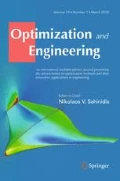Abstract
The power optimization problem and target assignment are investigated to improve low probability of interception (LPI) in a distributed radar network system. The target geometrical localization error and probability of detection are considered as QoS metrics of the network. We introduce geometrical fusion gain as a metric to fuse information for measuring target localization by multiple radars. The problem is then considered as an optimization challenge based on measurement error covariance ellipses, which satisfy detection and localization accuracy of the network. The LPI problem can be solved with two different objectives for the optimization as it minimizes the maximum power and cuts down on total power. Due to the combinatorial nonconvex and nonlinear nature of the optimization problems, relaxations are considered to make the problems more tractable. They can be efficiently solved by dividing them into two subproblems. Firstly, there is the power allocation in which a framework is proposed to compute minimum required power for a radar assignment scheme by applying a numerical method. Secondly, there is the radar assignment in which a heuristic assignment algorithm is suggested to acquire sufficient radar-to-target assignment based on calculated power. The simulation results show that the proposed algorithms considerably improve LPI performance while detection probability and target localization error constraints can be satisfied.











Similar content being viewed by others
References
Aittomki T, Godrich H, Poor HV, Koivunen V (2011) Resource allocation for target detection in distributed MIMO radars. In: 2011 conference record of the forty fifth Asilomar conference on signals, systems and computers (ASILOMAR). IEEE, pp 873–877. https://doi.org/10.1109/ACSSC.2011.6190133
Andargoli SMH, Malekzadeh J (2017) LPI optimization framework for search radar network based on information fusion. Aerosp Sci Technol. https://doi.org/10.1016/j.ast.2017.04.004
Boyd S, Vandenberghe L (2009) Convex optimization. Cambridge University Press, Cambridge, pp 215–273
Doughty SR (2008) Development and performance evaluation of a multistatic radar system. PhD dissertation, University of London, pp 22–60
Du K-L, Swamy MNS (2016) Search and optimization by metaheuristics: techniques and algorithms inspired by nature. Birkhuser, Cham
Godrich H, Haimovich AM, Blum RS (2008) Cramer Rao bound on target localization estimation in MIMO radar systems. In: 42nd annual conference on information sciences and systems, 2008. CISS 2008. IEEE, pp 134–139. https://doi.org/10.1109/CISS.2008.4558509
Godrich H, Petropulu AP, Poor HV (2011) Power allocation strategies for target localization in distributed multiple-radar architectures. IEEE Trans Signal Process 59(7):3226–3240. https://doi.org/10.1109/TSP.2011.2144976
Koch W (2013) Tracking and sensor data fusion: methodological framework and selected applications. Springer, Berlin, pp 31–51
Li F, Gao X, Li B (2014) A study on search strategies of netted surveillance radar. In: International conference on logistics engineering, management and computer science (LEMCS 2014). Atlantis Press. https://doi.org/10.2991/lemcs-14.2014.54
Ma B, Chen H, Sun B, Xiao H (2014) A joint scheme of antenna selection and power allocation for localization in MIMO radar sensor networks. Commun Lett IEEE 18(12):2225–2228. https://doi.org/10.1109/LCOMM.2014.2365206
Neri F (2006) Introduction to electronic defense systems. SciTech Publishing, Raleigh, pp 24–36
Northrop Grumman (n.d.) AWACS Surveillance Radar: The Eyes of the Eagle. Falls Church, Va, Northrop Grumman. http://www.northropgrumman.com/Capabilities/AWACSAPY2/Documents/AWACS.pdf
Pace PE (2009) Detecting and classifying low probability of intercept radar. Artech House, Boston, pp 3–37, 316–360
Rice SO (1944) Mathematical analysis of random noise. Bell Syst Tech J 23(3):282–332
Richards MA, Scheer JA, Holm WA (2010) Principles of modern radar: basic principles. SciTech Publishing, Raleigh, pp 87–111, 677–710
Rihaczek AW (1969) Principles of high-resolution radar. McGraw-Hill
Shi C, Zhou J, Wang F, Chen J (2013) Target threatening level based optimal power allocation for LPI radar network. In: Instrumentation and measurement, sensor network and automation (IMSNA). IEEE, pp 634–637. https://doi.org/10.1109/IMSNA.2013.6743357
Shi C, Wang F, Sellathurai M, Zhou J (2014) LPI optimization framework for target tracking in radar network architectures using information-theoretic criteria. Int J Antennas Propag. https://doi.org/10.1155/2014/654561
Teng Y (2010) Fundamental aspects of netted radar performance. PhD dissertation, UCL (University College London), pp 35–73
Author information
Authors and Affiliations
Corresponding author
Rights and permissions
About this article
Cite this article
Hosseini Andargoli, S.M., Malekzadeh, J. LPI radar network optimization based on geometrical measurement fusion. Optim Eng 20, 119–150 (2019). https://doi.org/10.1007/s11081-018-9401-x
Received:
Revised:
Accepted:
Published:
Issue Date:
DOI: https://doi.org/10.1007/s11081-018-9401-x




